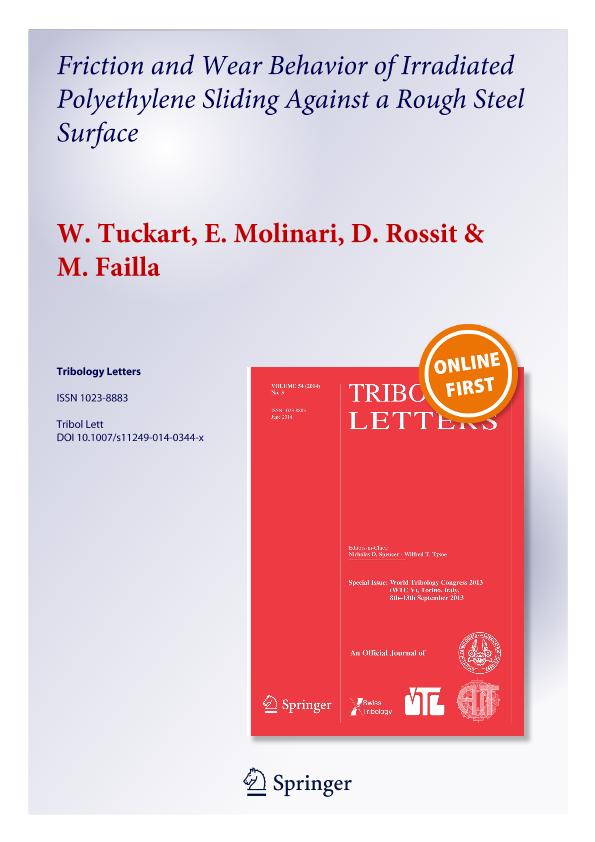Mostrar el registro sencillo del ítem
dc.contributor.author
Tuckart, Walter Roberto

dc.contributor.author
Molinari, Erica Cintia

dc.contributor.author
Rossit, Daniel Alejandro

dc.contributor.author
Failla, Marcelo Daniel

dc.date.available
2017-07-28T20:58:29Z
dc.date.issued
2014-07
dc.identifier.citation
Tuckart, Walter Roberto; Molinari, Erica Cintia; Rossit, Daniel Alejandro; Failla, Marcelo Daniel; Friction and wear behavior of irradiated polyethylene sliding against a rough steel surface; Springer; Tribology Letters; 55; 1; 7-2014; 165-176
dc.identifier.issn
1023-8883
dc.identifier.uri
http://hdl.handle.net/11336/21605
dc.description.abstract
The aim of this study was to evaluate the tribological behavior of polyethylene crosslinked by gamma radiation sliding against a steel surface. Two high-density polyethylenes were irradiated to a total dose in the range of 2−20 Mrad under vacuum and at room temperature. After irradiation, the materials were annealed at 423 K and then cooled slowly to room temperature. The same thermal treatment was applied to the non-irradiated polymer. The wear behavior of the polymers was determined under controlled ambient temperature of 298 and 333 K using a homemade tribometer. Sheet-shaped specimens were loaded against the surface of a steel disc with different normal loads to generate nominal contact pressures in the range of 0.25–1.5 MPa. The tests were performed under dry conditions using a disc rotation to produce an average sliding speed of 0.6 m/s and during a period of time to provide an average sliding distance of 1,080 m. The wear rate was obtained as the mass loss by the sample divided by the sliding distance, and the friction coefficient was determined by measuring the friction force. The results indicate that the wear rate increases with load in the case of non-irradiated polyethylene and low-dose irradiated polymers, while the wear rate reaches a maximum value with the load in the case of the irradiated samples with high doses. The samples irradiated with a dose of 10 Mrad showed the lowest wear. The coefficient of friction (COF) increases slightly with the load in all the cases. Most irradiated polymers show higher COF than the non-irradiated material when compared at a given load. The results show that the irradiation dose applied to the polyethylenes produced no noticeable effect on the COF values when a comparison was made at a given applied load.
dc.format
application/pdf
dc.language.iso
eng
dc.publisher
Springer

dc.rights
info:eu-repo/semantics/openAccess
dc.rights.uri
https://creativecommons.org/licenses/by-nc-sa/2.5/ar/
dc.subject
ABRASIVE WEAR
dc.subject
CROSS-LINKED
dc.subject
FRICTION
dc.subject
POLYETHYLENE
dc.subject.classification
Ingeniería de los Materiales

dc.subject.classification
Ingeniería de los Materiales

dc.subject.classification
INGENIERÍAS Y TECNOLOGÍAS

dc.title
Friction and wear behavior of irradiated polyethylene sliding against a rough steel surface
dc.type
info:eu-repo/semantics/article
dc.type
info:ar-repo/semantics/artículo
dc.type
info:eu-repo/semantics/publishedVersion
dc.date.updated
2017-03-03T19:37:12Z
dc.identifier.eissn
1573-2711
dc.journal.volume
55
dc.journal.number
1
dc.journal.pagination
165-176
dc.journal.pais
Estados Unidos

dc.journal.ciudad
Nueva York
dc.description.fil
Fil: Tuckart, Walter Roberto. Universidad Nacional del Sur. Departamento de Ingeniería; Argentina. Consejo Nacional de Investigaciones Científicas y Técnicas; Argentina
dc.description.fil
Fil: Molinari, Erica Cintia. Universidad Nacional del Sur. Departamento de Ingeniería; Argentina. Consejo Nacional de Investigaciones Científicas y Técnicas; Argentina
dc.description.fil
Fil: Rossit, Daniel Alejandro. Universidad Nacional del Sur. Departamento de Ingeniería; Argentina. Consejo Nacional de Investigaciones Científicas y Técnicas; Argentina
dc.description.fil
Fil: Failla, Marcelo Daniel. Consejo Nacional de Investigaciones Científicas y Técnicas. Centro Científico Tecnológico Conicet - Bahía Blanca. Planta Piloto de Ingeniería Química. Universidad Nacional del Sur. Planta Piloto de Ingeniería Química; Argentina
dc.journal.title
Tribology Letters

dc.relation.alternativeid
info:eu-repo/semantics/altIdentifier/url/https://link.springer.com/article/10.1007/s11249-014-0344-x
dc.relation.alternativeid
info:eu-repo/semantics/altIdentifier/doi/http://dx.doi.org/10.1007/s11249-014-0344-x
Archivos asociados
